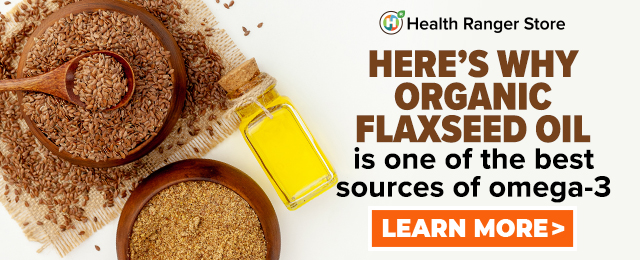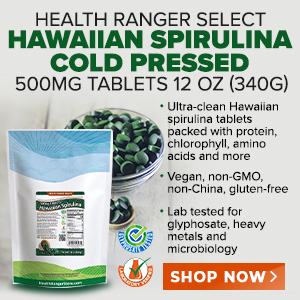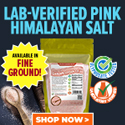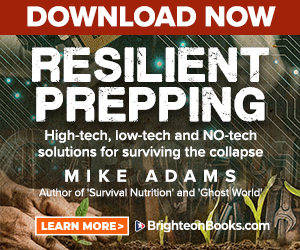
Choosing the Right Foods for Your Family Can Make a Significant Nutritional Difference
Friday, October 24, 2008 by: Leigh Erin Connealy, M.D.
Tags: nutrition, health news, Natural News
- Aerosolized bioweapons? Strange “diploid biomasses” falling out of the sky in Florida captured under the microscope
- Widespread social and economic unrest: Steve Quayle issues urgent financial warning of imminent asset collapse in new interview with Mike Adams
- U.S. lawmakers investigate Meta over alleged China collaboration
- Israeli lobbyists boast of controlling US national security policy in leaked AIPAC audio
- Analysis: The coming economic collapse, a mass uprising and Trump's three secret weapons to halt the growing revolt
- Fauci is back in the limelight, and he’s busy promoting a future COVID or FLU pandemic
- Kiss Your Genetic Privacy Good-Bye! 23andMe Gets Green Light to Sell Your Intimate Genetic Details to Anyone They Want
- Warp Speed 2.0: Trump Administration ACCELERATES Gates-funded, self-amplifying bird flu vaccines
- Mike Adams releases country western hit single: Goin’ Back in Time is Comin’ Home
- TAKE IT DOWN Act advances in Congress amid free speech concerns
- 6 Seemingly safe US states you should avoid when SHTF
- DMSO and Natural Dyes: A suppressed cancer treatment resurfaces in independent research
- CLOT SHOT PLANDEMIC UNFOLDING: Fibrous, rubbery clots caused by covid injections have prion-like seeding activity
- Tulsi Gabbard leads charge against the Biden regime’s global censorship of the 'Disinformation Dozen'
- Father speaks out: Challenging the mainstream narrative of his daughter’s “unvaccinated measles death”
- Chemical cocktails in processed foods linked to diabetes, validating natural health warnings
- Defunding DEADLY mRNA jabs: Government funding for mRNA technology being scrutinized and sidelined until proven "safe and effective" for real
- Curcumin’s ancient healing power supercharges muscle recovery, and its effects are compounded with anti-inflammatory foods and supplements
- Aerosolized bioweapons? Strange “diploid biomasses” falling out of the sky in Florida captured under the microscope
- Fauci is back in the limelight, and he’s busy promoting a future COVID or FLU pandemic
- Tulsi Gabbard leads charge against the Biden regime’s global censorship of the 'Disinformation Dozen'
- Analysis: The coming economic collapse, a mass uprising and Trump's three secret weapons to halt the growing revolt
- Widespread social and economic unrest: Steve Quayle issues urgent financial warning of imminent asset collapse in new interview with Mike Adams
- Kiss Your Genetic Privacy Good-Bye! 23andMe Gets Green Light to Sell Your Intimate Genetic Details to Anyone They Want
- U.S. lawmakers investigate Meta over alleged China collaboration
- Mike Adams releases country western hit single: Goin’ Back in Time is Comin’ Home
- Israeli lobbyists boast of controlling US national security policy in leaked AIPAC audio
- Chemtrails unveiled: How the CIA and Big Business are manipulating the weather for profit
- Curcumin’s ancient healing power supercharges muscle recovery, and its effects are compounded with anti-inflammatory foods and supplements
- CLOT SHOT PLANDEMIC UNFOLDING: Fibrous, rubbery clots caused by covid injections have prion-like seeding activity
- China’s counter-tariff strategies: A new chapter in the U.S.-China trade war
- Pfizer's RSV vaccine linked to preterm births as drug giant CONCEALED RISKS from pregnant women in unethical clinical trials
- Shedding light on the dark side of MMR vaccines: How vaccinated individuals SPREAD MEASLES & put the vulnerable at risk
- Dane Wigington exposes climate engineering as ‘All-Out Weather and Biological Warfare’
- Defunding DEADLY mRNA jabs: Government funding for mRNA technology being scrutinized and sidelined until proven "safe and effective" for real
- DEATH by VACCINE or face PRISON time: Canadian Freedom Convoy leaders CONVICTED for protesting forced vaccination during the Covid Plandemic
- Newly released JFK files reveal Pentagon's role in creating Lyme disease and covid in the same lab
- Analysis: The coming economic collapse, a mass uprising and Trump's three secret weapons to halt the growing revolt
- Mike Adams releases country western hit single: Goin’ Back in Time is Comin’ Home
- Aerosolized bioweapons? Strange “diploid biomasses” falling out of the sky in Florida captured under the microscope
- Kiss Your Genetic Privacy Good-Bye! 23andMe Gets Green Light to Sell Your Intimate Genetic Details to Anyone They Want
- European Court of Justice: Healthcare professionals who promoted or administered COVID-19 vaccines are CRIMINALLY LIABLE for any harm caused
- Federal employees whine over DOGE's new directive requiring them to do a 5-point summary of weekly accomplishments
- U.S. approves new Russian ambassador as diplomatic thaw continues
- Government waste exposed: Hegseth supports Musk’s demand for accountability from federal workers
- Now you can HEAR chemistry: Health Ranger translates molecules into music in stunning video demonstration that will blow your mind (and your ears)
- Widespread social and economic unrest: Steve Quayle issues urgent financial warning of imminent asset collapse in new interview with Mike Adams
- Dr. Mike Yeadon releases 15-minute testimony - WATCH - about genocidal intent of COVID “vaccines”
- The Health Ranger releases “Vaccine Zombie” song and music video, using AI-animated zombies for the music video
- Trump reverses course on Gaza plan, says “nobody is expelling Palestinians”
- EPA advisor admits the agency is funneling billions to climate groups ahead of Trump’s return to White House
- 5 Simple steps to boost your brainpower: How to strengthen executive function in a distracted world
- I Want My Bailout Money – new song and music video released by Mike Adams
- Tulsi Gabbard leads charge against the Biden regime’s global censorship of the 'Disinformation Dozen'
- Red Cross issues warning to stop blood plasma donations from vaccinated people
- Scientists confirm: GENIUS brain function can be spontaneously unleashed in humans without any apparent cause
- EPA advisor admits the agency is funneling billions to climate groups ahead of Trump’s return to White House
- HYSSOP: What research reveals about the health benefits of this ancient holy herb
- Two containers with completed ballots fall out of truck in Florida
- Newly released JFK files reveal Pentagon's role in creating Lyme disease and covid in the same lab
- Global leaders unite to clamp down on “misinformation” with UN-backed Cascais Declaration
- BREAKING: 2025 NDAA authorizes mandatory military draft of WOMEN across America… as Pentagon pursues global NUCLEAR war with both Russia and China at the same time
- Mike Adams releases country western hit single: Goin’ Back in Time is Comin’ Home
- Michael Yon warns of a ZIONIST TAKEOVER in Trump’s second administration
- Ozempic and Wegovy weight loss drugs are injectable LIZARD VENOM PEPTIDES that may unleash a devastating wave of organ failure… side effects align with symptoms of SNAKE BITES
- The Health Ranger releases “Vaccine Zombie” song and music video, using AI-animated zombies for the music video
- BOMBSHELL: DNA testing kits are a SCAM to develop ethnic-specific bioweapons
- Israeli soldiers accused of even more torture and abuse in the West Bank
- These 13 countries just signed an agreement to engineer a global FAMINE by destroying food supply
- I Want My Bailout Money – new song released by Mike Adams
- NASA admits that climate change occurs because of changes in Earth’s solar orbit, and NOT because of SUVs and fossil fuels
- RFK Jr. clears key hurdle: Sen. Susan Collins backs controversial HHS nominee, signaling a new era for health policy
Let's start with what makes something "organic". Organic refers to the agricultural process used to produce food and fiber. All kinds of agriculture products are produced organically, including produce, grains, meat, dairy, eggs, fibers, flowers and processed food products. Organic food is produced without using most conventional pesticides, petroleum- or sewage-sludge based fertilizers, bioengineering or ionizing radiation. Organic meat, poultry, eggs and dairy products come from animals that are given no antibiotics or growth hormones. Before a product can be labeled "organic", an inspector visits the farm where the food is produced to make sure that the farm meets the USDA's strict standards.
But why choose organic over the standard fair found in your average grocery stores? Let's look at how organic farming differs from conventional farming in the methods used to grow crops.
* Where traditional farmers apply chemical fertilizers to the soil to grow their crops, organic farmers feed and build soil with natural fertilizer.
* Traditional farmers use insecticides to get rid of insects and disease, while organic farmers use natural methods such as insect predators and barriers for this purpose.
* Traditional farmers control weed growth by applying synthetic herbicides, but organic farmers use crop rotation, tillage, hand weeding, cover crops and mulches to control weeds.
The result is that conventionally grown food is often tainted with chemical residues, which can be harmful to humans. The Environmental Protection Agency (EPA) considers 60% of herbicides, 90% of fungicides and 30% of insecticides to be carcinogenic. Human exposure to pesticides can lead to a host of other problems as well, including neurotoxicity, disruption of the endocrine system (hormones), immune suppression and could affect the male reproduction function or lead to miscarriages in women.
Additionally, conventional produce tends to have fewer nutrients than organic produce. On average, conventional produce has only 83% of the nutrients of organic produce. Studies have revealed significantly higher levels of nutrients such as vitamin C, iron, magnesium and phosphorus, and significantly less nitrates (a toxin) in organic crops. For easy access to organic nutrients, try perfectlyhealthy Mega Greens plus MSM. It includes certified organic greens to provide you the nutrients that you are missing in your food as well as helping you balance your pH Levels.
When it comes to meat and poultry, you may have heard the term "grass fed", but what does that mean? No antibiotics, growth hormones, fertilizers, herbicides or pesticides are used when raising grass fed animals. Parasites are controlled primarily through preventative measures such as rotational grazing, balanced diet, sanitary housing, and stress reduction. The result? A nutritionally superior food source containing less fat, fewer calories, more beta carotene, a lower risk of e-coli and more Conjugated Linoleic Acids (CLAs), which block tumor growth, reduce obesity, reduce the risk of diabetes and stimulate the immune system.
The meat from grass fed animals is also 2 to 5 times higher in omega-3 fatty acids. Omega-3 fatty acids belong to a group of polyunsaturated fats called essential fatty acids because they are necessary to life and health, yet we cannot make them in the body -- they must be obtained from the diet. Like all fats, omega-3s provide energy. Their caloric value is similar to other fats and oils, but unlike saturated fats, they have important health roles. These fatty acids are fundamental molecules in the structure and activity of the membranes of all cells throughout the body and hold highly specialized functions in neurological tissues, especially the brain and retina. Because of their role in cell membranes, omega-3s are essential for the formation of new tissue and are therefore important for development and growth. They also play a major role in the prevention and management of certain diseases and chronic conditions.
In these modern times that we are living in, we are faced with daily bombardment from toxins in our water, our air, the products that we use, and especially our food. By buying organic and grass fed products, you are taking charge of your health and making a conscious choice to care about your future and wellbeing. With all of the dangers that we are forced to confront, make your dinner table a safe haven for your family and loved ones. I have gathered a few of my favorite organic recipes and provided them for you to indulge in. Why not treat the special people in your life to a meal to live for, rather than a meal to die for?
Roasted Turkey - Serves 15 to 20 people
Ingredients
* Organic Cornbread Turkey Sausage Stuffing with Apples (recipe follows)
* 1 organic turkey, 18 to 22 pounds (Shelton)
* 2 large oranges, cut into halves
* ¼ pound (1 ½ sticks) organic sweet butter at room temperature
* salt and freshly ground black pepper, to taste
* paprika, to taste
* 4 tablespoons olive oil
Instructions
Wash the turkey well, inspecting for pinfeathers, and chop off the wing tips, reserving them for later use with giblets in gravy or stock. Dry the turkey inside and out with a kitchen towel. Squeeze the juice from the 2 oranges all over the outside of the bird and rub into the cavity to re-freshen. Salt and pepper the cavity to taste. Fill the turkey with the stuffing, not packing too tightly. Sew up the cavity or close with small trussing skewers. Rub the outside of the turkey all over with 1 stick of the softened butter and sprinkle generously with salt, pepper and paprika. Drape the turkey with cheesecloth. Place turkey, breast side up, on a rack in a roasting pan. Four to five hours before is scheduled, place the turkey in a preheated 325 degree oven. Melt the remaining 4 tablespoons of butter with 4 tablespoons of olive oil in a saucepan. Lift the cheesecloth from the turkey and baste every 30 minutes, first with butter and oil mixture and later with the turkey's own juices.*
Roast for 3½ to 4¼ hours or until the thigh juices run clear yellow when pricked with a skewer. There should be no traces of pinkness. The drumstick will move easily in the socket when the turkey is done. When the turkey is done, remove to a heated platter and cover with foil. The turkey should stand 30 minutes before carving. Remove stuffing into a bowl. If there is any additional from the recipe, bake it in a covered casserole in a 350 degree oven, covered with foil, for one half hour before serving.
* For a moist bird, frequent basting is essential, so don't forget! Baste every 30 minutes—breast and legs should be a lovely golden color.
Organic Cornbread-Sausage Stuffing with Apples - Enough stuffing for a 20-pound turkey, to make 12 to 14 portions
Ingredients
* 12 tablespoons (1½ sticks) organic sweet butter
* 2½ cups finely chopped yellow onions
* 3 tart apples, cored and chunked; do not peel
* 1 pound lightly seasoned organic turkey sausage (a vegetarian breakfast sausage with sage is best)
* 3 cups coarsely crumbled organic cornbread (preferably homemade)
* 3 cups coarsely crumbled Eizeil bread
* 3 cups coarsely crumbled French bread
* 2 teaspoons dried thyme
* 1 teaspoon dried sage
* salt and freshly ground black pepper, to taste
* ½ cup chopped Italian parsley
* 1½ cups shelled pecan halves
Instructions
Melt half of the butter in a skillet. Add chopped onions and cook over medium heat, partially covered, until tender and lightly colored, about 25 minutes. Transfer onions and butter to a large mixing bowl. Melt remaining butter in the same skillet. Add apple chunks and cook over high heat until lightly colored but not mushy. Transfer apples and butter to the mixing bowl. Crumble the sausage into the skillet and cook over medium heat, stirring, until lightly browned. With a slotted spoon, transfer sausage to the mixing bowl. Add remaining ingredients to the ingredients in the mixing bowl and combine gently. Cool completely before stuffing the bird.
Arugula and Sweet Red Pepper Salad - Serves 6
Ingredients
* 2 packages of organic baby greens
* 2 bunches of arugula
* 1 pound fresh mushrooms
* 3 large sweet red peppers
* Balsamic Vinaigrette (recipe follows)
* 1 can organic heart of palms
Instructions
Discard outer leaves of lettuce; separate and rinse the inner leaves and dry thoroughly. Remove arugula leaves from their stems, rinse, and dry thoroughly. Remove stems from the mushrooms and wipe each mushroom cap with a damp paper towel or cloth. Cut away the stems and ribs of the red peppers; discard the seeds. Slice peppers into fine julienne. Slice heart of palms into rows.
To assemble, tear the lettuce leaves into bite-size pieces and combine with the arugula. Divide among 6 chilled salad plates. Slice mushrooms and sprinkle evenly over greens. Arrange red pepper julienne and heart of palms over mushrooms. Drizzle each plate with Balsamic Vinaigrette and serve immediately.
Balsamic Vinaigrette - Makes about 1¼ cups
Ingredients
* 1 garlic clove, unpeeled
* 1 tablespoon prepared Dijon-style mustard
* 3 tablespoons balsamic vinegar*
* salt and freshly ground black pepper, to taste
* 1 cup best-quality olive oil
Instructions
Cut garlic clove into halves and rub the cut sides over the inner surface of a small bowl. Reserve the garlic. Whisk mustard and vinegar together in the bowl. Season with salt and pepper to taste. Dribble oil into the bowl in a slow steady stream, whisking constantly, until dressing is creamy and thickened and all the oil has been incorporated. Taste and correct seasoning. Add reserved pieces of garlic; cover the bowl and let the dressing stand at room temperature until you need it. Remove garlic and re-whisk the dressing if necessary before using.
Green Beans and Celery - Serves 6
Ingredients
* 1½ lb green beans, trimmed
* ¼ cup unsalted butter or ¼ cup olive oil
* 1 cup sliced yellow onion
* 4 large celery stalks, cut on the diagonal into strips ¼ inch wide
* 1 cup sliced toasted almonds, optional
* salt and freshly ground pepper
Instructions
Bring a large saucepan three-fourths full of salted water to a boil. Add the green beans and boil until tender-crisp, 3-5 minutes. Drain, immerse in ice water to stop the cooking and drain again. Pat dry with paper towels and cut into 2-inch lengths. Set aside.
In a large sauté pan over medium heat, melt the butter or warm the oil. Add the onion and sauté, stirring, until tender and translucent, 8-10 minutes. Add the celery, raise the heat slightly and stir and toss for 3-4 minutes. Add the green beans and almonds (if using) and heat to serving temperature. Season to taste with salt and pepper. Transfer to a warmed dish and serve immediately.
Baked Butternut Squash with Apples and Maple Syrup - Serves 12
Ingredients
* 2 ½ to 2 ¾ pounds butternut squash, peeled, quartered length-wise, seeded, cut crosswise into ¼-inch-thick slices (about 6 cups)
* 2 pounds medium-size tart green apples, peeled, quartered, cored, cut crosswise into ¼-inch-thick slices (about 6 cups)
* ½ cup dried currants
* ground nutmeg
* ½ cup pure maple syrup
* ¼ cup butter (½ stick), cut into pieces
* 1½ tablespoons fresh lemon juice
Instructions
Preheat oven to 350 degrees F. Cook squash in large pot of boiling salted water until almost tender, about 3 minutes. Drain well. Combine squash, apples, currants in 13 x 9 x 2-inch glass baking dish. Season generously with nutmeg, salt and pepper. Combine maple syrup, butter and lemon juice in heavy small saucepan. Whisk over low heat until butter melts. Pour syrup over squash mixture and toss to coat evenly.
Bake until squash and apples are very tender, stirring occasionally, about 1 hour. Cool 5 minutes.
Cranberry-Tangerine Conserve - Serves 6
Ingredients
* Finely grated zest of 3-4 tangerines
* 2 cups fresh tangerine juice
* 1 cup Xylitol natural sweetener or raw Turbano sugar
* ½ teaspoon ground ginger
* ½ teaspoon ground cinnamon
* 4 cups cranberries
Instructions
In a sauce pan over high heat, combine the tangerine zest, 1 ½ cups of the tangerine juice, Xylitol or Turbano, ginger and cinnamon. Bring to a boil, stirring to dissolve the Xylitol or Turbano sugar. Reduce the heat to medium and simmer, uncovered, for 10 minutes. Add the cranberries and cook until the berries pop and the mixture starts to bubble, 5-7 minutes longer.
Stir in the remaining ½ cup tangerine juice and continue to simmer, stirring occasionally, until the cranberries are tender and the juices are syrupy but not too thick, 10-15 minutes. The syrup will continue to thicken as the conserve cools.
Remove from the heat, transfer to a bowl and let cool. Serve at room temperature.
Pears in Raspberry Sauce - Serves 6
Ingredients
* 3 firm Bosc or Bartlett pears
* ¼ cup organic raspberry jam or jelly
* Juice of 1 orange (or ½ cup orange juice)
* Pinch ground cinnamon or nutmeg
* Pinch salt
* 2 tablespoons mirin or white wine (optional)
* Fresh raspberries, strawberries and fresh mint leaves, for garnish
Instructions
Preheat oven to 350 degrees F. Slice the pears in half and scoop out the seeds with a spoon. Place the pears sliced side down in a baking dish. Combine jam or jelly, juice, cinnamon or nutmeg, salt, and mirin, wine, and pour over pears. Cover the dish with foil or a lid, and bake until the pears are soft when pierced with a fork, about 30 minutes. To serve, turn the pears over and spoon some raspberry sauce over them. Garnish with berries and mint.
For products that I developed and recommend visit (www.perfectlyhealthy.net) .
About the author
Leigh Erin Connealy, M.D. has specialized in Integrative Medicine for over twenty years, using conventional and natural methods to determine and discover the "root of the cause" in her clinic, Center for New Medicine in Irvine, California, each and every day. Many people come in to the clinic from all over the world with severe chronic illnesses that conventional medical protocols have been unsuccessful treating. She realized early on that she can truly change lives through education as well as treatment protocols.Leigh Erin Connealy, M.D. and her medical staff strives to look at the whole person while exploring the effects and relationships among nutrition, psychological and social factors, environmental effects and personal attunement. Out of frustration of trying to find the right products to help her patients she formulated the perfectlyhealthy brand of products. All perfectlyhealthy products are clinically tested. For more information on recommended products, please visit www.perfectlyhealthy.net or www.perfectlyhealthy.com.
Nutrition at FETCH.news
Get independent news alerts on natural cures, food lab tests, cannabis medicine, science, robotics, drones, privacy and more.
Take Action: Support Natural News by linking to this article from your website
Permalink to this article:
Embed article link: (copy HTML code below):
Reprinting this article:
Non-commercial use OK, cite NaturalNews.com with clickable link.
Follow Natural News on Facebook, Twitter, Google Plus, and Pinterest
Science News & Studies
Medicine News and Information
Food News & Studies
Health News & Studies
Herbs News & Information
Pollution News & Studies
Cancer News & Studies
Climate News & Studies
Survival News & Information
Gear News & Information
News covering technology, stocks, hackers, and more



"Big Tech and mainstream media are constantly trying to silence the independent voices that dare to bring you the truth about toxic food ingredients, dangerous medications and the failed, fraudulent science of the profit-driven medical establishment.
Email is one of the best ways to make sure you stay informed, without the censorship of the tech giants (Google, Apple, Facebook, Twitter, YouTube, etc.). Stay informed and you'll even likely learn information that may help save your own life."
–The Health Ranger, Mike Adams












































